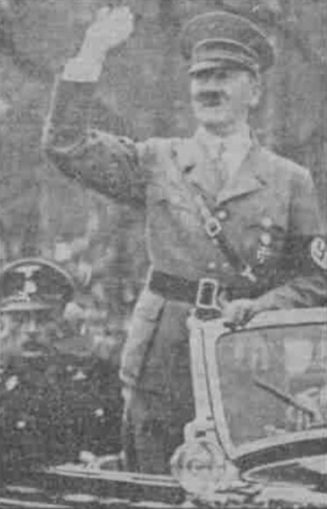This is my uncle John Alldridge’s article for the Manchester Evening News on the 10th anniversary of Hitler’s death on 30 April, 1945 – Jerry F
By today it was clear the Reichswehr had had enough. German soldiers were coming into the cages now in whole divisions – 125,000 men in the last 48 hours. The British Lowland Division crossed the Elbe and was racing for the Baltic; Americans were in the heart of Munich. Everywhere the Western Allies and Russians were linking up as the remains of Nazi Germany melted away. One by one the stalags were being overrun and their occupants released to a freedom they could scarcely believe.
Himmler, whose surrender offer to Britain and the U.S. had been refused, was still trying vainly to arrange a separate cease-fire through a neutral, Count Bernadotte of Denmark. And Hitler? No one knew for certain at the time, but reports grew that he was dead. One said he had died, a raving lunatic, in a bunker beneath the Tiergarten. . . .
This is Berlin at 10 minutes past two 2 on the afternoon of April 30, 1945. In a bomb-proof room buried 50 feet under the garden of the Reich Chancellery a man lies dead. The acrid smoke still billows in that sumptuously appointed room, with its Flemish masterpieces on the walls, its Dresden china, its Persian carpets, its monogrammed furniture.
Half-sitting, half-lying on a blue-and-white sofa, arms dangling, the body of Adolf Hitler, born Schickelgruber, has fallen forward on a little table, from which his head, mouth agape is dripping blood.
A pistol – a heavy Walther 7.65 – lies on the floor within reach of one dead hand.
Huddled against him, her head on his left shoulder, reclines his wife of a few hours. Eva Braun Hitler. Her pretty face looks dull and stupid in death.
The Fuhrer is dead. But the outraged expression on that face is not that of a suicide. Rather it is that of a martyr who has been murdered – by his generals, by his army, by the whole German people, by the world that could not appreciate his greatness.
Death at his own hand must have been the last indignity, the supreme surprise, in the 56 years of unholy life granted to Adolf Hitler. For he believed he had been born under a lucky star.
The great tyrants of history were all born with this absolute self-assurance, an assurance they backed up with the blunderbuss of power. And no man believed in himself more completely than Hitler.
When he emerged, shaken but undamaged, from the bomb attempt of July 1944, they found him hysterical with joy. This proved him superhuman, he told them, with almost reverent awe.
But it is the fate of tyrants to die unmourned, forgotten even in that moment of disintegration.
Just one hour before his death Hitler had taken a tearful farewell of his friends. Then, like rats leaving a sinking ship, the bemuddled generals and diplomats disappeared into the Wagnerian gloom.
Hans Messerer, on duty in the Reich Chancellery at the end, recalls:
“I heard no discussion about Hitler after his death. We had more important things to talk about.”
What were his thoughts in those last chaotic moments, “this evil man” as his great adversary Churchill called him; this master-gangster on whose conscience lay more human misery than the world had known since the days of Ghengis Khan?
We can be sure that there was no twinge of remorse. For if Hitler had taken a model it would have been that other world-conqueror, that other Hun, Attila.
“Above all, Duce,” he wrote to his sleeping partner Mussolini in December, 1941. “Above all, it often seems to me that human development has only been interrupted for fifteen hundred years and is about to resume its former character.”
Attila would have been proud of his pupil. In some high-level Hell reserved for arch-criminals Nero would have nodded approval at the skill with which he dispatched his political rivals on that “Night of the Long Knives”, June 30, 1934.
“Lists of victims were drawn with the composure of invitations to a golf match”, we are told. “And under Hitler’s personal direction the selectees were murdered in cold blood.”
He plunged the world into war with the methodical precision of a financier planning a killing on the Stock Exchange.
“I am 50 years old. I would prefer war now than when I am 55 or 60,” he told the British Ambassador just a week before his tanks rumbled into Poland.
Out of his own mouth he is condemned.
That he did die in that bomb-proof room and that we now know the details of his death is due almost entirely to one man. Hugh Trevor-Roper, an Oxford don and historian.
He was in British Military Intelligence in Germany in September, 1945, and was commissioned to find out the facts and report them by November 1. He studied documents and analysed the workings of the Nazi Reich to deduce who might have been expected to form Hitler’s entourage at the critical moment – not only the State and Service chiefs, but also typists and guards.
Trevor-Roper, incidentally, established that in his last years Hitler had a tremor down his left side, had swollen glands and stooped.
His general appearance was senile and he was a broken man.
Mr. Trevor-Roper prepared his report in time. The following summer he embodied his conclusions in a best-seller, “The Last Days of Hitler”.

Hitler in Berlin, 1937,
Unknown photographer – Reach/British Newspaper Archive/British Library Board
Adolf Schickelgruber, the child of an illegitimate son of Maria Ann Schickelgruber, had come a long way to find his destiny in that cellar rocking under a collapsing Reich.
“What an artist dies in me!” The last words of Nero would have come appropriate from his lips. If it hadn’t been for the dirty Jews he would have been a great artist, too. They laughed at his watercolours when he was a student in Vienna. Well, he had got his own back on the Jews all right!
Beside his body on the table is a sheaf of photographs. Each shows a picture of a dead and mutilated general.
If Hitler had lived, if his fantastic, megalomaniac schemes had succeeded, he could have died as comfortably as any old-time Chicago gangster.
His book, “Mein Kampf”, became a world best-seller; it sold eight million copies and at times seriously rivalled the Bible.
He owned a controlling interest in the “Voelkischer Breobachter”, the party newspaper. The amount of booty taken in his name by the invading armies of the Wehrmacht totalled two billion pounds.
Yes, Frau Schickelgruber’s grandson, the one-time village constable of Hildburghausen, running around serving summonses on wife-beaters, had certainty come a long way.
And perhaps in that moment of truth, listening to his world – the world that was to have lasted for 1,000 years – collapsing in ruin around him, he thought it all worth while.
Guernica, Warsaw, Coventry, Belsen – all had been a means to this end. It was so ordained. Another Siegfried was about to die. So that another, greater Siegfried would rise from the ashes.
And so, with diabolic cunning, he planned his last trick. Immediately after his death, secretly and without witnesses, they were to burn his body so that no trace of him should be found. Then, in a few years, the legends would start. The spirit of Adolf Hitler, the Fuhrer, would live on.
And he was right. For in remote corners of Germany today you will see the evil weed growing from the seed he planted. The Fuhrer is not dead. He escaped by submarine, by aeroplane, by magic carpet.
That was the artful legend in which Hitler hoped to find immortality. But he had forgotten the written word, the irrefutable testimony that could destroy the myth at any time. . . .
We are in that gloomy courtroom at Nuremberg. A pale-faced witness is giving evidence:
“Moennikos and I went direct to the pits. Now I heard rifle-shots in quick succession from behind one of the earth mounds. The people who had got off the trucks – men, women, and children of all ages – had to undress upon the orders of an S.S. man, who carried a riding or dog whip. I saw a heap of about eight hundred to a thousand piles of underlinen and clothing. . . .
“I walked around the mound and found myself confronted by a tremendous grave. People were closely wedged in and lying on top of each other so that only their heads were visible. Some of the people shot were still moving. The pit was already two-thirds full. I estimated that it already contained about one thousand people. I looked for the man who did the shooting
“He was an S.S. man, who sat on the edge of the narrow end of the pit, his feet dangling into the pit. He had a tommy gun on his knees and he was smoking a cigarette ….”
This horror was committed on the direct order of Adolf Hitler, the man of whom his former State Secretary for Special Assignments, Wilhelm Keppler, protested long after his death: “In many things he was too good.”
With the news of his death a shudder must have run through Hell.
Credits:
Text and Picture:
The British Newspaper Archive (www.britishnewspaperarchive.co.uk)
The British Library Board
© Reach PLC
Jerry F 2022



